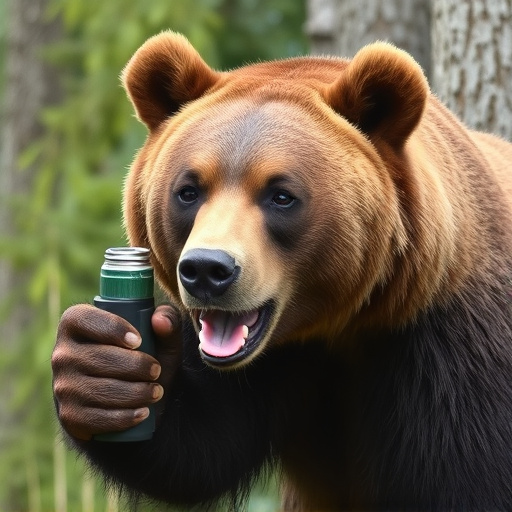Bear spray, an effective deterrent against bears in natural habitats, uses capsaicin to temporarily incapacitate them. Its residue can reach up to several meters and target bears' faces and respiratory systems. However, the active ingredients can harm non-target wildlife and ecosystems if not disposed of properly, leading to soil and water pollution. Balancing human safety with ecological preservation is crucial, especially in biodiverse areas. Effective usage requires strategic timing, aiming for sensitive areas, using short bursts, and maintaining safe distances, along with proper training to minimize negative impacts on wildlife.
“Unveiling the Maximum Stopping Power of Bear Spray: A Comprehensive Guide. Bear spray, a crucial defense mechanism in wildlife encounters, has sparked interest for its effectiveness against bears. This article delves into the science behind bear spray, exploring its composition and how it interacts with the environment through residue analysis. We dissect the ethical implications of its use on wildlife and provide valuable insights on maximizing stopping power through proper application techniques. By understanding these aspects, users can ensure responsible and effective protection in potential bear encounters.”
- Understanding Bear Spray: Composition and Effectiveness
- Bear Spray Residue: How It Works and Environmental Impact
- Wildlife Impact: Considerations for Ethical Use
- Maximizing Stopping Power: Application Techniques and Best Practices
Understanding Bear Spray: Composition and Effectiveness
Bear spray, also known as bear deterrent or bear repellent, is a powerful tool designed to protect individuals from potential bear encounters in their natural habitats. Its primary purpose is to incapacitate bears temporarily, allowing humans to escape or defend themselves. The key component of bear spray is capsaicin, the same chemical that gives chili peppers their heat and pungent flavor. This substance irritates the eyes, nose, and throat of bears, causing them to back away and avoid the source of irritation.
The effectiveness of bear spray relies on proper usage and understanding. When sprayed correctly, it creates a residue that can travel up to several meters, providing a defensive barrier. The impact on wildlife is minimal when used responsibly, as it is specifically targeted at bears and does not harm other animals or the environment. It’s crucial to follow instructions and ensure the spray reaches the bear’s face and respiratory system for maximum stopping power while minimizing any negative consequences for the surrounding ecosystem.
Bear Spray Residue: How It Works and Environmental Impact
Bear spray residue plays a pivotal role in its effectiveness as a defense mechanism against bears. When sprayed, the active ingredients in bear spray—typically capsaicin and other chili pepper derivatives—form a viscous liquid that adheres to the bear’s fur, eyes, nose, and mouth. This residue irritates the sensitive mucous membranes, causing the bear to recoil and retreat. The mechanism is designed to incapacitate the animal temporarily, providing the user with an escape route.
However, the environmental impact of bear spray residue is a growing concern. Capsaicin can persist in the environment for extended periods, potentially affecting non-target wildlife and ecosystems. Studies have shown that residual capsaicin can harm birds, fish, and other animals that come into contact with contaminated surfaces or water bodies. Additionally, improper disposal of used bear spray can contribute to soil and water pollution, underscoring the importance of responsible use and disposal practices to minimize the wildlife impact of bear spray residue.
Wildlife Impact: Considerations for Ethical Use
When considering bear spray as a defense mechanism, it’s crucial to weigh its impact on wildlife. Bear spray residue can persist in the environment, potentially affecting non-target species and ecosystems. This includes animals that may come into contact with the sprayed area, either directly or through water sources where the spray has settled. The ecological footprint of bear spray use should be carefully considered, especially in areas known for diverse wildlife populations.
Ethical considerations demand a responsible approach to bear spray usage. Users must be mindful of the broader implications and strive to minimize negative impacts on local ecosystems. This involves understanding the behavior and habitats of wildlife in the region, as well as adhering to guidelines and regulations designed to protect both humans and animals.
Maximizing Stopping Power: Application Techniques and Best Practices
Maximizing the stopping power of bear spray requires a deep understanding of application techniques and best practices. One key factor is ensuring proper timing; spraying directly into the bear’s face, especially around the eyes, nose, and mouth, can significantly impair its vision and breathing, providing crucial seconds to escape or gain shelter. The unique aerosolized nature of bear spray residue plays a vital role; it coats the animal’s sensitive areas, causing pain, disorientation, and temporary blindness.
Best practices also include using the spray from a safe distance, typically 20-30 feet away, and spraying in short bursts to create a cloud that lingers. It’s important to remember that bear spray is not a foolproof defense; its effectiveness varies based on factors like wind direction, weather conditions, and the bear’s size and aggression. Regular training and familiarity with the spray’s operation are essential to ensure its maximum wildlife impact when needed.
Bear spray is an essential tool for personal safety in bear country, but understanding its composition, application, and environmental impact is crucial. By maximizing stopping power through proper technique and ethical considerations regarding wildlife impact, individuals can ensure their safety while minimizing the residual effects on the environment. Remember that responsible use of bear spray is key to coexisting harmoniously with these majestic creatures.
